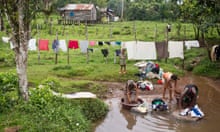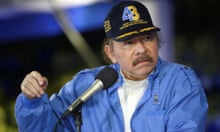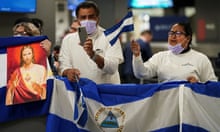The death toll from anti-government protests in Nicaragua has risen to 25 as the national police were accused of using live rounds against demonstrators.
Those killed include Ángel Gahona, a journalist who was shot dead while presenting a live broadcast on protests in Bluefields, a town on the country’s Caribbean coast.
Grainy, night-time footage shows Gahona holding up a mobile phone as he approaches city hall, reporting live via Facebook on four days of protests in the Central American country.
Seconds later a gunshot rings out and Gahona slumps lifeless to the kerb. Voices cry his name and someone presses a piece of cloth to his head to try to staunch the stream of blood. Footage of the incident quickly spread on to local and social media.
According to human rights groups, 25 people have died since 18 April in unrest over social security reforms planned by the government of president Daniel Ortega. At least 67 people have been shot by the police with live rounds or rubber bullets, or beaten by members of the Sandinista Youth and other pro-government groups. A further 43 people were reported to have “disappeared” over the weekend.
Speaking to tens of thousands of people during his Sunday address in St Peter’s Square, Rome, Francis called for “an end to every form of violence” and asked people “to avoid the useless shedding of blood”.
Francis, the first Latin American pope, called for differences to be resolved peacefully and with a sense of responsibility.
Snipers were reportedly placed in Nicaragua’s national stadium to shoot at protesters holed up in Managua’s cathedral. The demonstrators symbolically pulled down one of the brightly coloured Tree of Life sculptures erected in the capital by the vice-president, Rosario Murillo, Ortega’s wife.
The disturbances turned increasingly violent on Friday, with police using teargas and live rounds against protesters armed with stones.
In the city of León, university offices were torched after riot police broke up a peaceful protest. The ruling Sandinista National Liberation Front’s digital publication El 19 Digital blamed the fires on “groups of vandals”, but protesters claimed they were started by government sympathisers to justify its increasingly repressive measures.
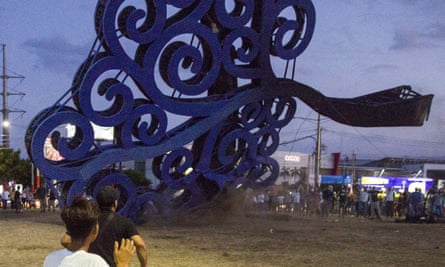
On Friday night, the Nicaraguan army was deployed in Estelí and Managua armed with AK-47s to “safeguard public institutions”, according to El 19 Digital.
Ortega, who is facing the biggest crisis of his leadership, said on Saturday that he was ready to consider changing an unpopular social security overhaul announced last week, which would increase worker contributions and lower pensions. He said, however, that talks would only be held with business leaders and not with other sectors of society.
He also appeared to try to justify what has been a heavy-handed response by the government and allied groups, accusing protesters – most of them university students – of being manipulated by rightwing parties funded from the US and infiltrated by gangsters.
“What is happening in our country has no name,” Ortega said. “The kids do not even know the party that is manipulating them ... Gang members are being brought into the kids’ protests and are criminalising the protests. That is why they are put at risk.”
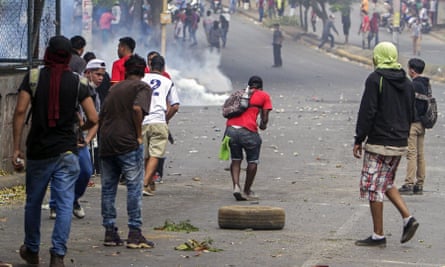
Those remarks appeared to fan the flames, as a short time later on Saturday afternoon thousands of people spilled back on to the streets in seven cities including the capital, after tensions had calmed somewhat on Friday night.
Mauri Hernandez, one of the protesters, said: “We are in the streets asking for Ortega and his wife to go. This has already gone beyond the social security issue. Here there have been dead, wounded, and he does not even apologise for his killings or the savage repression against the people.” COSEP, Nicaragua’s powerful business association, has called for a private sector march on Monday and offered to negotiate with the government. Since the government came to power in 2007, however, COSEP has been among its closest allies.
Protesters on social media accused COSEP of coming to the government’s rescue, while at the same time presenting itself as a champion of civic struggle to achieve its own objectives.
The UN human rights office has expressed concern about the violence, and called on Nicaraguan authorities to stop further attacks on protesters and the media.

